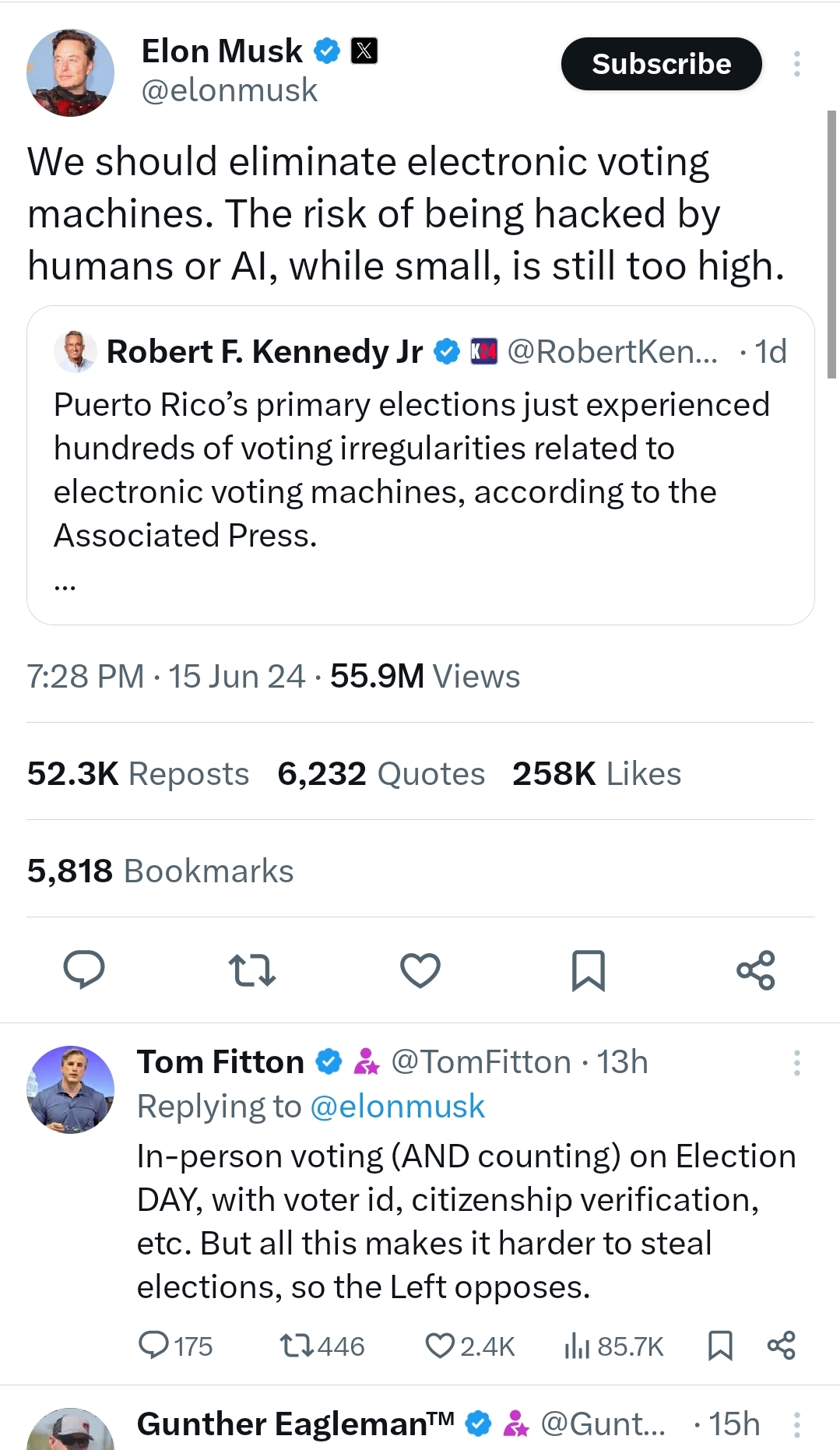this post was submitted on 17 Jun 2024
261 points (86.8% liked)
People Twitter
5974 readers
989 users here now
People tweeting stuff. We allow tweets from anyone.
RULES:
- Mark NSFW content.
- No doxxing people.
- Must be a pic of the tweet or similar. No direct links to the tweet.
- No bullying or international politcs
- Be excellent to each other.
- Provide an archived link to the tweet (or similar) being shown if it's a major figure or a politician.
founded 2 years ago
MODERATORS
you are viewing a single comment's thread
view the rest of the comments
view the rest of the comments

Electronic voting is by definition not trustworthy enough.
A working election system needs to accomplish a few very contradictory things, while the voter needs to be annonymous, the system still needs to verify that one citizen only get's one vote, the system also need to count each vote.
In the Swedish system, on election day you go to your polling station, you get three envelopes, you go behind a screen and pick the ballots for the party you want to vote for, if you want to be extra anonymous you grab one from each party, you do that for all three elections (state, region and municipality), they are colour coded and the envelopes have a small cutout to make the color visible.
You then go behind another screen and put your ballots in the envelopes and seal them, you then take your envelopes, walk over to the election officials, hand them your ID, votes and election card.
One election official reads your name and ID number, the other finds you in the list, the first election official confrims that the second is ready, and they then say "voted white, voted blue, voted yellow" as each envelope with the coresponsig ballot is placed in the proper urn.
After the polling station closes, they deal with the pre votes and mail votes, they check all election cards against the list, and if someone has voted in person, the pre vote or mail vote is tossed, if not they are processed just as normal.
Then all votes are counted to get a total, if there are more votes than there should be, if just a few then I have heard it being resolved by tossing random votes.
Then the envelopes are opened, and ballots sorted and counted, anyone may come in and watch the process at any point.
This can't be done on a computer in a way that anyone should trust
It’s not accurate to say that electronic voting is inherently untrustworthy. That’s a subjective opinion rather than a fact.
There are countries that have successfully used electronic voting for a long time without significant issues. Since you’re European to begin with, take Estonia for example - their system is world class. Look it up.
Voter anonymity isn’t an issue exclusive to digital voting either. Standard voting systems also have to ensure that votes are cast anonymously while verifying the voter’s identity. With electronic voting, cryptography can be used to protect voter identity and maintain anonymity and it’s very effective.
You can also use advanced security measures like multi-factor authentication, biometric verification, and other technologies. There’s a metric shitload of ways to enhance security in electronic voting.
Electronic voting can be designed to be more secure and transparent than in-person. Blockchain can create tamper-proof records and paper audit trails for verification. Anything that can’t be verified can be excluded and investigated.
It’s ridiculous to dismiss electronic voting outright because the things you are worried about can already happen in traditional voting.
The problem with electronic is that by it's nature it can't do secrecy while preserving integrity.
That is just not possible, and if you can have your vote linked back to you in anyway after having cast it, then the system is bad.
And this is not getting into the whole black box problem, there is no way to verify that the system is actually running the code it should.
You are trusting a black box built by other people with their own political agendas, or who possibly has been influenced by other interests.
I am well aware of Estonia's voting system, I would never trust it if I had use it.
There is just too much money and power combined with voter secrecy involved in the election process that it can't be trusted to software.
And on the other hand.. if I vote can’t be linked back to anyone, then you have a whole other problem. So maybe voting in general is able to be manipulated no matter what.
Black box voting are designed to to be transparent and they are open source so the public can scrutinize.
Why don’t you trust Estonias voting system? You didn’t give a reason. Look up VVPAT.
I don't trust the concept of electronic voting.
Sure, the voting software might be open source, great, that doesn't mean that the code is actually running on the voting system at the time of election.
With electronic voting it is increadibly easy to skew a result, you just change the code and make every vote for A be worth 1, and every vote for B be worth 0,7 or so, then take the number of votes missing from B and remove them from the total number of votes.
With paper ballots that is a big logistical challange.
Then we come to the point of voter secrecy, that is entirely impossible to accomplish while maintaining voter verification in an electronic voting system, both of these objectives are critical to a proper voting system, and but you can only do either one of them in sn electronic voting system.